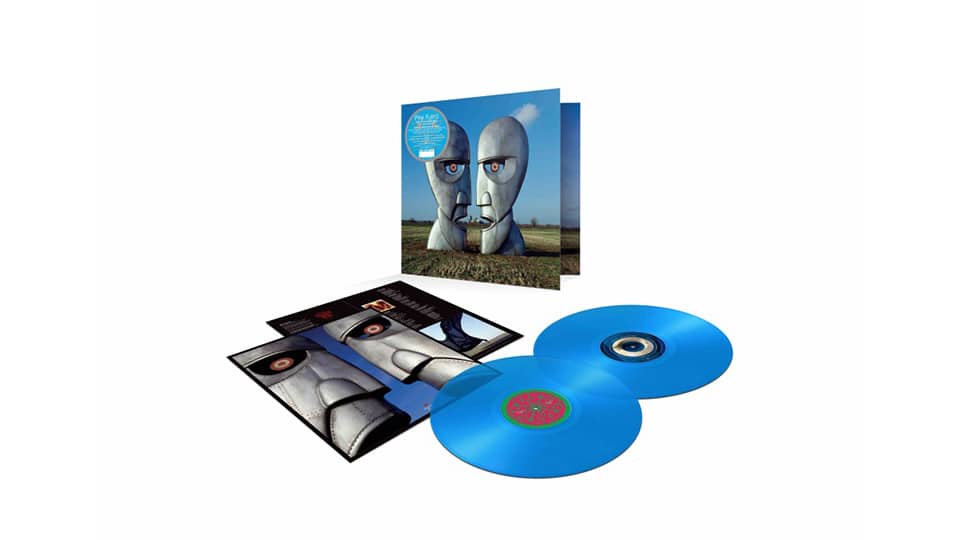Pink Floyd’s The Division Bell first appeared in 1994, and it was the band’s last offering for two decades until 2014’s The Endless River. It followed from the acrimonious departure of brilliant yet spiky creative driving force Roger Waters, and 1987’s indifferent A Momentary Lapse in Reason, which was the band’s first material of their post-Waters phase.
Now, to celebrate the 25th anniversary of its debut, The Division Bell has been re-issued in limited edition blue vinyl. This release contains two heavyweight LPs with gatefold sleeve and two inner full-colour inner sleeves holding all of the lyrics and many striking images. Artist Storm Thorgerson, who created many of the iconic covers for the band’s catalogue, produced some of his best work for the Division Bell, which depicts two large metal heads facing each other in a field – Ely Cathedral visible between their mouths. One of the merits of vinyl is being able to enjoy great album cover artwork.
The Division Bell itself is a huge improvement on A Momentary Lapse in Reason. Pink Floyd always struggled without Roger Waters’ skill for creating concepts and strong lyrics. David Gimour, the celebrated guitarist, was not a natural songwriter, but although lyricists were (wisely) brought in to add some heft to the songs, the success of The Division Bell is that the artistic collaboration between David Gilmour and keyboardist Richard Wright is a productive one – possibly even more so without the dominating personality of Waters on the scene.
The opening, Cluster One, is classic Pink Floyd. Cheekily, with the atmospheric music and sound effects, it appears to borrow from Roger Waters’ solo album Amused to Death, which had appeared a few years earlier. Nevertheless, it very successfully invites listeners into the world of the album. The fourth track, Marooned, is another instrumental, and an even better example of Gilmour and Wright’s brilliance together. Strange, ethereal, poignant – it’s a stunningly beautiful piece of music.
The rest of The Division Bell consists of songs on the theme of communication – possibly a dig at Waters, whose concept for The Wall had famously been about paranoid isolation. There are certainly no bad tracks on the album. The blues-influenced What Do You Want From Me benefits from a strong showing for Gilmour’s guitar, though the backing singers give it an oddly dated feel. Poles Apart has a more laidback, pastoral feel, and journeys into a vintage Pink Floyd digression into unsettling circus music, complete with crying baby sound effects, before slamming back into the song with an uplifting key change. Great stuff.

Although the album maintains a coherent sound and coalesces successfully around particular themes, there are moments where it becomes a touch formulaic. A Great Day for Freedom, thematically interesting, on the aftermath of the fall of the Berlin Wall, is repetitive, reaching for Gilmour’s guitar work to take it in a more interesting direction. Later on, Lost For Words repeats the formula – decent song but forgettable. Wearing the Inside Out isn’t one of the standouts either, but it does have the novelty value of a rare turn at leading vocals for Richard Wright (who is also credited with writing it).
Despite the few lulls in brilliance, The Division Bell builds towards a satisfying climax. Take It Back is good solid rock fayre, Coming Back to Life brilliantly takes its time in the first half, with the guitar picking out the melody long before Gilmour’s vocals kick in. Perhaps one of the most moving tracks on the album, it has something of a feel of Eric Clapton.
A highlight of the album is Keep Talking, which used the standard Pink Floyd soundscape to create mood, feeding in the words of Stephen Hawking, but breaking new ground for the band by proving that they could adapt to the times. After the routine Lost for Words, the album goes out on High Hopes – a stunning and satisfyingly dramatic piece with strong percussion from Nick Mason. The Division Bell is worth it for the sheer majesty of High Hopes alone, which proves the track that stays in the mind afterwards, along with Cluster One, Marooned and Coming Back to Life.
Pink Floyd without Roger Waters was always going to struggle lyrically, but with The Division Bell, David Gilmour proved that the band could liberate themselves and move in a fresh new direction, creating a strong and coherent vision punctuated by moments of sheer musical brilliance. The Division Bell builds on Pink Floyd’s legacy and brings the band up to date. There are good reasons why some fans hail it as amongst the band’s best albums. It’s certainly their most creative offering since 1977’s Animals.
Four out of five for the musical content, which has more than its share of flashes of classic Floyd, whilst also successfully navigating new territory. An extra half a star awarded for the limited edition packaging to celebrate 25 years of The Division Bell’s existence.
Track listing: Cluster One, What Do You Want From Me, Poles Apart, Marooned, A Great Day For Freedom, Wearing The Inside Out, Take It Back, Coming Back To Life, Keep Talking, Lost For Words, High Hopes Record Label: Pink Floyd Records Release Date: 7th June 2019 Buy The Division Bell


